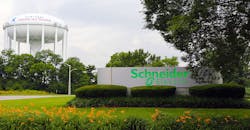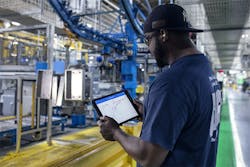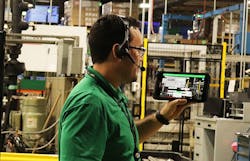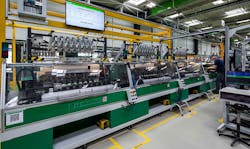Green New Feel: Inside Schneider Electric's First U.S. Smart Factory
Lexington, KY is known for its Thoroughbreds—sinewy horses carefully bred and trained to run hard but also use every joule of energy wisely. You could say a smart factory runs the same way.
These manufacturing facilities leverage competitive advantages such as the Industrial Internet of Things, robots, and data analytics to boost productivity and reduce waste. That's why it's fitting that last month Schneider Electric chose to convert its Lexington plant into its first American smart factory. There are 41 Schneider factories overall in North America, the only other "smart" one is in Mexico.
The 485,000-ft2 plant, opened in 1957, produces 2.8 million load centers and 800,000 safety switches per year. The French energy and automation solution provider hopes that adding its EcoStruxure IoT-enabled architecture and platform—along with many related applications and edge devices—will spur all of industry to race towards a more sustainable future.
The Plant
Climate alarmists say we only have 12 years to finish the sustainability race—by completely rethinking how buildings are made and energy is used. Everything must change, and fast, they say. On June 13, the day of the Lexington plant's relaunch, I attended the first tour and was struck by how it was remodeled in the spirit of sustainability, but with nary an apocalyptic warning to be found. Instead, we found only real, scalable examples. Maybe that's the benefit of being around since 1836; you're not easily swayed.
Schneider, named ninth most sustainable company in 2015, is open to change, though, especially when it comes to technology.
At each station in the plant, a green-shirted guide was holding a tablet—an increasingly common sight throughout the company's operations.
"In the last two years, tablets in the hands of employees have grown tenfold because everything we are doing has become digitized," says Ken Engle, Senior V.P. of Supply Chain, North America for Schneider, and the plant manager at Lexington 12 years ago."
What digitalization has enabled us to do is provide immediate info to the right people to solve the problem."
Those guides also pointed to giant monitors during their talks, which boasted impressive achievements brought about by gradually smartening up, like eliminating 90% of paperwork and reducing downtime 5% by alerting appropriate leaders and technicians.
"The biggest differences I see is the speed at which the factory runs compared to when I was here 12 years ago, and also the efficiency at which it runs," Engle says.
"People are more connected, more engaged, and therefore we have better ideas and better innovation."
The whole thing could be perceived as a not-so-subtle sales pitch for various edge devices, the overall EcoStruxure platform, or maybe the AVEVA asset management software. It could also be viewed as a compelling argument for why Schneider boldly and frequently refers to itself as the leader in the digital transformation of energy management and automation. But all I saw, and what at its heart this smart factory represents, is the unbridled optimism that the digital transformation can create not only a more profitable business but a better world.
Schneider currently has more than 200 factories, 60 of which can be classified as "smart." By the end of 2020, it wants that number to hit 100. What's going on here could inspire that number to increase exponentially, if customers are swayed by the results.
EcoStruxure's use is broad and serves all industries, from factories and grid providers to office buildings and hospitals. Some notable improvements include increasing equipment availability by 50% to reducing carbon footprint by half. Cost for maintenance can reduce by as much as 75% and plant savings overall are 30% on average.
Lexington is now one of 11 Schneider plants where customers are encouraged to visit to see the various EcoStruxure-driven innovations, which range from RFID tracking to data visualization, in action. A brownfield site was deliberately chosen to show how the various branches of EcoStruxure can thicken into solid trunks on which to build a digital strategy. So far, it's got an outstanding track record, slashing critical equipment repair time by 20% with its AR app and boosting year-over-year energy savings by 3.5% with power monitoring software.
"We understand the value of IIoT and the positive business impact that innovation and digitization can have on our operations—particularly in our global supply chain," says Mourad Tamoud, E.V.P. of Schneider Electric's global supply chain.
"As a living example of how our EcoStruxure solutions deliver benefits to our customers, we are gaining those same benefits in our operation and sharing that knowledge."
Tamoud mentioned during the opening remarks that the energy required to power the world in 20 years will double, while fossil fuel consumption will need to drop by 80%.
"This is the major megatrend that we have to embrace and help our customers and help our communities to be ready for the challenges of tomorrow," says Tamoud, who notes the manufacturer tries to be as green inside as its brand color is on the outside.
A big part of that is evangelizing the merger of energy management with industrial automation, explains Carlos Villa, V.P. of industry at Schneider Electric.
"There are incredible synergies and opportunities to unlock around energy savings when you can tie up your manufacturing information to your energy consumption," Villa says.
"And that is what I believe Schneider Electric does best in terms of what we provide to customers."
He says modularity is the key. As long as you are laying the groundwork for optimization in some areas, you have a foundation to add more.
"It's not about the size of the enterprise, but the business propositions you are trying to achieve," Villa says. "Once you prove that concept, you can build around that investment to expand to a larger coverage."
And the more applications you have, the better chance there is for meaningful change.
"We are opening infinite numbers of doors that we never thought about by measuring and starting to see a pattern," Villa says.
The Applications
Like with working out to shed unwanted pounds, there's no shame in starting small. Even if your doctor tells you that you're out of shape and severely at risk for a heart attack in 12 months, you wouldn't solve the problem by attempting a marathon on day one.
It's perfectly acceptable to start with small applications, such as EcoStruxure Augmented Operator Advisor. NED has long advocated for finding ways to put AR tech in the hands of workers, predating even the Pokémon Go zeitgeist, so it was great to see it being deployed more on the floor.
Schneider uses it for accessing relevant machine data by pointing the tablet camera at a machine or operation, and relevant data pops up on the screen. It runs through the Magelis iPC edgeBox and a PLC.
Using this to access info such as work instructions faster has resulted in a reduced mean time to repair by 20% at this plant.
Swiss industrial equipment provider Bühler also notes how it can hasten work.
"The speed of the resulting information display on the terminal is greater than what we could previously achieve using routing slips or other paper or electronic records," says Holger Feldhege, Bühler COO for manufacturing, logistics, and supply chain.
Villa says starting with AR would only cost about $5,000-10,000, and was a crucial piece to reducing paper by 90% at the plant. Tamoud says that Schneider is also deploying wearable headsets for maintenance work and to engage with remote experts that may be at the smart factory in Le Vaudreuil, France, but would have a closeup view of an issue at Lexington.
The number of IoT devices is set to grow ten times the current amount over the next few decades, Tamoud says, and Schneider is adding to that with RFID OsiSense. The sensor system—simple plug-and-play boxes—provides greater insight into inventory location. This has cut 128 miles of forklift travel per day from the plant, greatly increasing safety. The ROI was 33% in the first year and has cut $500,000 work-in-progress inventory and saved $1 million in material handling manpower costs.
Previously, Engle says automated material handling cut 50 forklifts from the plant in 2007. MiR automated mobile robots and self-driving Yale pallet trucks were also seen moving parts around.
Resource Advisor and Power Monitoring Expert may hold the greatest power for transformation. The software, paired with Schneider's expertise in energy purchasing, has helped Lexington save $6.6 million since 2012, and 3.5% year over year. The connected meters constantly feed data to the system, which is visualized on dashboards to indicate benchmarks and can alert management when a level dips too low.
"Customers know the threshold, but don't know exact scheduling, which lines they could slow down without affecting deliveries to stay within the range of the current energy consumption rates," Villa says. The outcomes are pretty incredible.
One of those customers, Saint-Gobain says it has saved $50 million by allowing Schneider to buy their energy for them.
Ryan Spies, Saint-Gobain's director of sustainability, says Resource Advisor empowers each level, from floor to management to the C-Suite to make the right moves by comparing plant data over time and against each other.
"It looks and finds our really good players, where we are using more energy, and where I should be helping the business and talking to senior management to get more capital," Spies says. "It's a tool we use to really evaluate our sites and make improvements and also recognize our high achieving plants."
Spies admits dealing with zero-waste emissions, renewable energy, and conserving water can be challenging, even for a 354-year-old company. But the former mirror manufacturer is probably more reflective than most on the subject, their CEO Pierre-André de Chalendar having written a book on climate change.
"Globally, we recognize the threat of climate change beyond just the cost savings on the operations side," Spies says. "We have a responsibility as a company to be stewards."
About the Author
John Hitch
Editor, Fleet Maintenance
John Hitch, based out of Cleveland, Ohio, is the editor of Fleet Maintenance, a B2B magazine that addresses the service needs for all commercial vehicle makes and models (Classes 1-8), ranging from shop management strategies to the latest tools to enhance uptime.
He previously wrote about equipment and fleet operations and management for FleetOwner, and prior to that, manufacturing and advanced technology for IndustryWeek and New Equipment Digest. He is an award-winning journalist and former sonar technician aboard a nuclear-powered submarine where he served honorably aboard the fast-attack submarine USS Oklahoma City (SSN-723).




